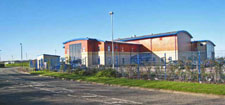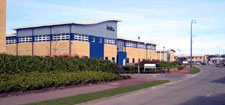Industry
The past dependence of the region on the declining industries of coal, steel and heavy engineering has lead to a major restructuring of the economy in the industrial landscapes of the coalfield. Many large new industrial estates have been developed around larger settlements and close to the strategic highway network. Future development is likely to take place on existing allocated and serviced (though as yet undeveloped) land and on New Prestige Employment Sites or Strategic Reserve Sites, some of which are in rural situations.
New industrial or commercial development can bring changes to the rural landscape in a number of ways.
- Rural or urban fringe countryside – often of value to local residents – may be lost to permanent development
- Mature landscapes and landscape features like hedgerows and hedgerow trees may be lost directly, or indirectly in the development of new roads and infrastructure.
- The character of the wider landscape may be affected by the visual intrusion of new industrial scale buildings.
- Local distinctiveness may be weakened by the introduction of ‘universal’ industrial buildings and building materials.
- The rural character of the countryside between settlements, and particularly along main transport corridors, may be eroded.
- The tranquillity of the surrounding countryside may be weakened by noise and light pollution and by increased traffic levels on local roads.
- The appearance of derelict or underused sites can be improved by high quality development.
There will be a continued need for new industrial development to meet the demands of a changing economy and the employment needs of local communities. It is important that such development does not detract from the character and quality of the countryside, which is important to both the quality of life of local people and to the marketing of County Durham as a high quality location for business.
Issues and Objectives
Planning for New Development
The Regional Spatial Strategy sets the strategic framework for the provision of land to meet employment needs. District Wide Local Plans and emerging Local Development Frameworks (LDFs) allocate specific sites for new development and contained more detailed policies. The overall objective of local planning policies is to accommodate new development on allocated sites well related to the main settlements and transport networks. Priority is given to the redevelopment of derelict or redundant sites. The Landscape Assessment and Strategy are contributing to the preparation of Local Development Frameworks, informing the identification of allocations for industry and providing guidance on landscape issues.
Objectives
- To inform LDF policies and allocations.
Guiding New Development
The impacts of new development are heavily influenced by the details of site selection and design. The County Durham Landscape Character Assessment provides baseline information on landscape character which can be used to inform these processes. Building-in Sustainability, the regional guide to sustainable building and development, provides guidance on how to adopt sustainability principles in building works. Further detailed guidance is needed on design principles and issues in different landscapes. A number of Supplementary Planning Documents (SPD) are being proposed as part of Local Development Frameworks to give further guidance on design issues.
Objectives
- To inform and support the development of a Supplementary Planning Documents dealing with design issues.
Existing Industrial Sites
Some existing industrial sites have a high standard of external screening and interior landscaping. Others – and particularly those that have developed in a piecemeal fashion – have a poor appearance in views from surrounding areas and lack an integrated approach to the management of elements like structure planting. Existing sites can be made more attractive to local people and businesses alike by environmental improvement works and offsite screening.
Objectives
- To encourage improvements to the environment of industrial sites.
Vacant Industrial Land
Vacant industrial land can have a run down and neglected appearance. There is little incentive to manage positively or create permanent landscape features where uncertainties exist over the form of future development. In some case permanent structure planting can be developed in advance of development, which will gain maturity and screening value in the interim. Some short-term uses of industrial land – for example as hay meadows – can have considerable biodiversity value.
Objectives
- To encourage positive management of vacant industrial land to improve its appearance and wildlife value.
- To encourage early structure planting on vacant and reserve sites.



